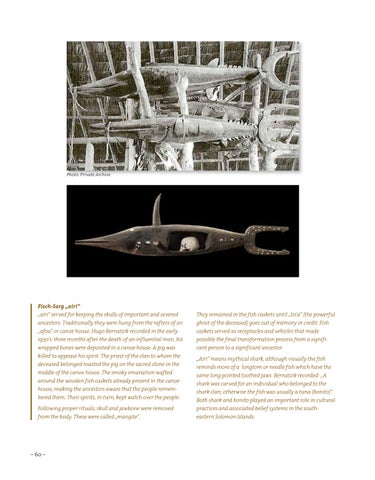Photo: Private Archive
Fisch-Sarg „airi“ „airi“ served for keeping the skulls of important and severed ancestors. Traditionally they were hung from the rafters of an „afoa“ or canoe house. Hugo Bernatzik recorded in the early 1930‘s: three months after the death of an influential man, his wrapped bones were deposited in a canoe house. A pig was killed to appease his spirit. The priest of the clan to whom the deceased belonged roasted the pig on the sacred stone in the middle of the canoe house. The smoky emanation wafted around the wooden fish caskets already present in the canoe house, making the ancestors aware that the people remembered them. Their spirits, in turn, kept watch over the people. Following proper rituals, skull and jawbone were removed from the body. These were called „mangite“.
– 60 –
They remained in the fish caskets until „lio‘a“ (the powerful ghost of the deceased) goes out of memory or credit. Fish caskets served as receptacles and vehicles that made possible the final transformation process from a significant person to a significant ancestor. „Airi“ means mythical shark, although visually the fish reminds more of a longtom or needle fish which have the same long pointed toothed jaws. Bernatzik recorded: „A shark was carved for an individual who belonged to the shark clan; otherwise the fish was usually a tuna (bonito)“. Both shark and bonito played an important role in cultural practices and associated belief systems in the southeastern Solomon Islands.
